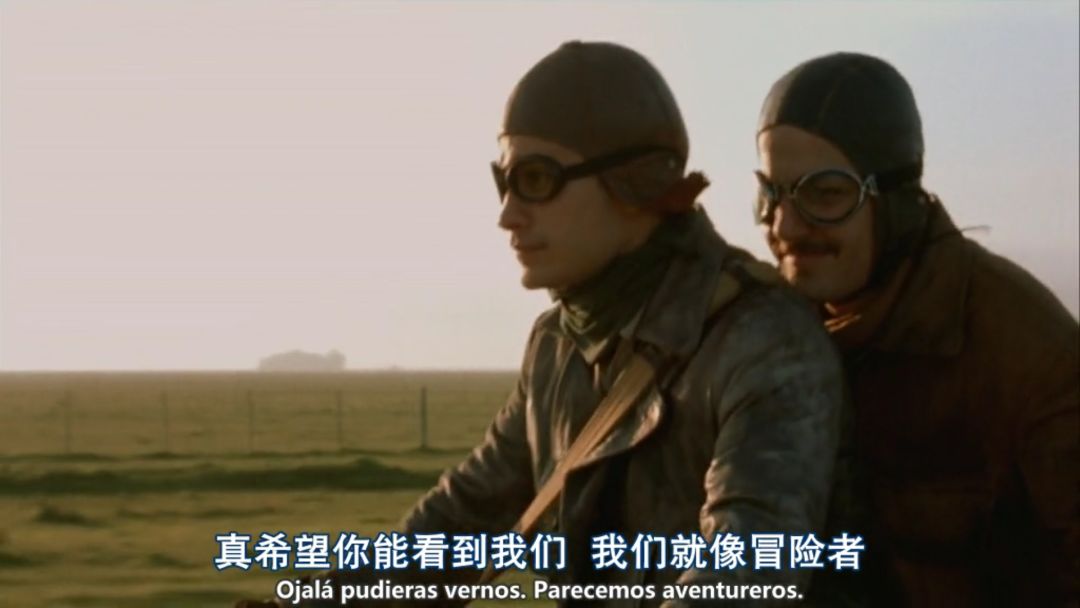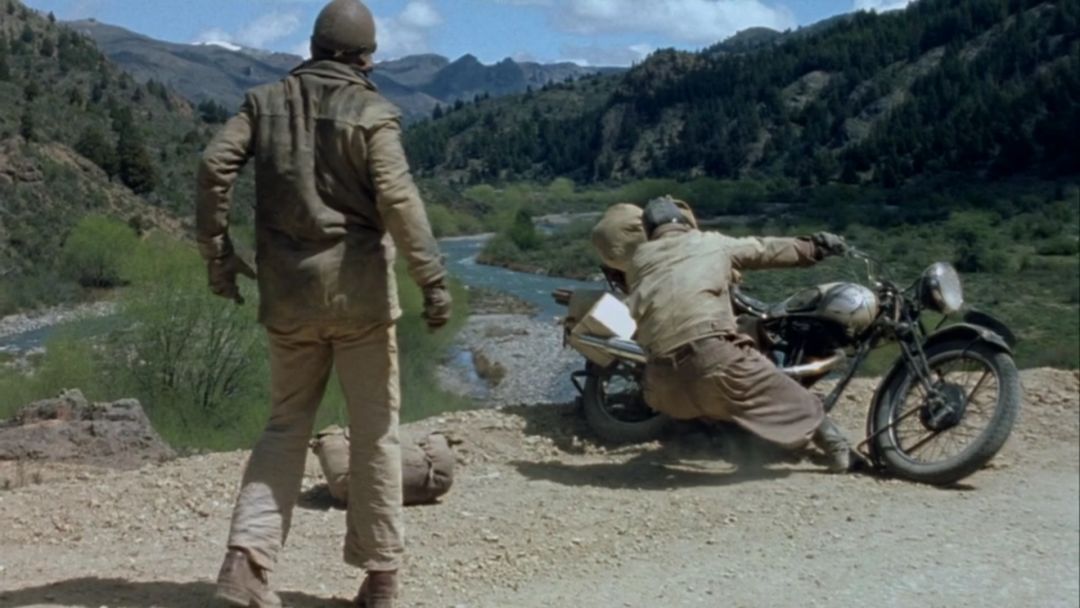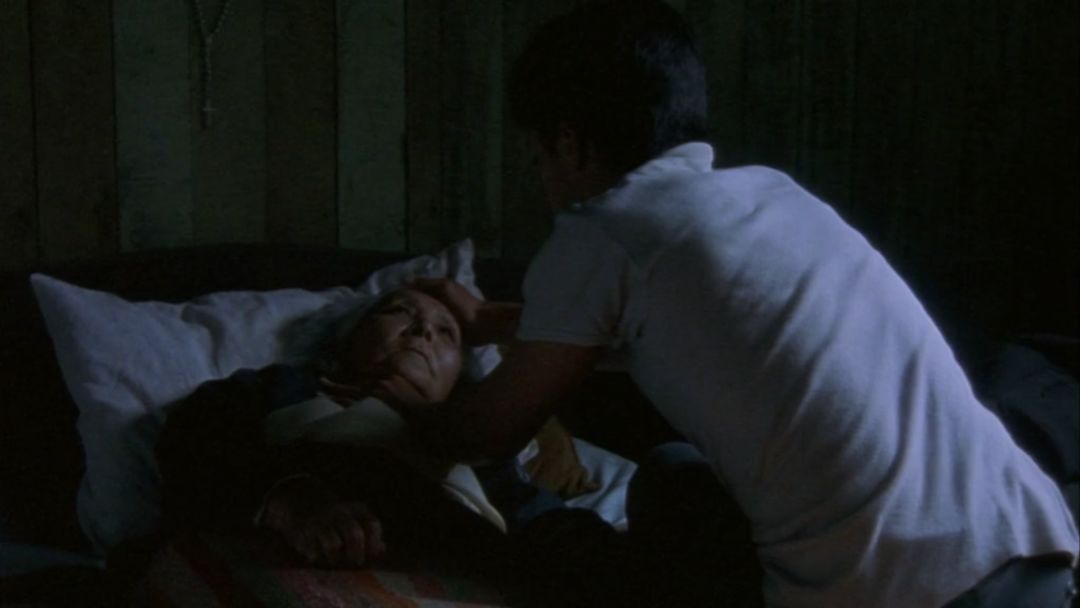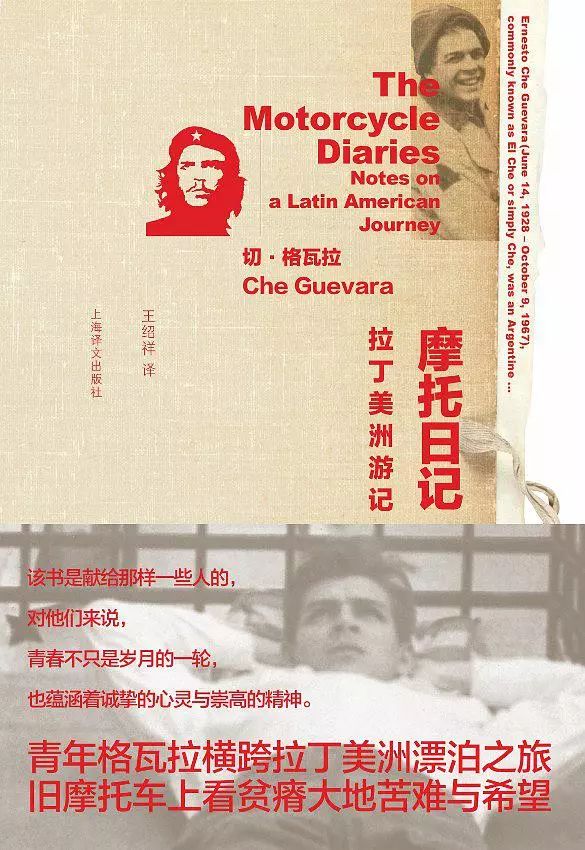An oil leaking Norton 500 motorcycle, two restless young people, a journey of thousands of miles, wandering across South America.
In 1952, Ernesto Guevara bid farewell to his comfortable life, started his motorcycle engine, and went to explore the wild land with his friends.
When he returned to his hometown again, the casual young man disappeared. His life took on a new direction, leading him to become Che Guevara, the hero who liberated Cuba and sparked revolution across Latin America.
“
Wearing a beret, bearded face, and firm and deep eyes, Che Guevara’s face often appears on T-shirts and posters. It is a totem of rebellious youth around the world and a symbol of freedom and independence. (Unless otherwise specified, all pictures in this article are from the movie “Motorcycle Diary”)

Che Guevara, whose real name was Ernesto Guevara, was born on June 14, 1928 in Rosario, Argentina. He is an Argentine Marxist revolutionary, doctor, writer, guerrilla leader, military theorist, politician, and core figure in the Cuban Revolution, who once fought alongside Castro. Image source: chugunka10.net
Everyone who walks on the road has or has encountered this face. Why is he so popular with young people? José Rivera, the screenwriter of the movie “Motorcycle Diary”, tried to explain Che Guevara’s youth:
This is a story about searching and ideals. Young people of every age need such a story about their journey. Being in another place, being exposed to a new culture, meeting strangers, and changing yourself because of it. (Source: entertainment.time.com)

The Motorcycle Diary movie poster.
A trip without hesitation
In 1952, Che Guevara was still a student named Ernesto. He and his friend Alberto Granado (Alberto Granado) were going to set off from Buenos Aires to the northernmost tip of the South American continent .
At the age of 23, Ernesto went on a long journey——Ernesto was about to graduate from medical school in one year at that time. Standing at the crossroads of his life at the age of 23, the future was clearly visible: becoming a respected doctor, getting married and having children, and living a comfortable life middle-class life. Therefore, when he announced that he was going to leave school for a trip, his mother was full of hesitation and worry, and his father was even more resolutely opposed:
You only have three courses left to become a doctor! (Source of information: “Motorcycle Diary”)
However, the heart of the young man has long been restless. His friend Alberto drew on the map casually, and his thoughts followed all the way to the north.

Planned route: From Buenos Aires to Patagonia, then to Chile, then up six kilometers north, along the Andes to Machu Picchu. From there to San Pablo in the Peruvian Amazon, where there is a leprosy hospital. The final destination is Venezuela’s Guajira Peninsula, the northernmost tip of the South American continent. Image source: “Motor Diaries: Travels in Latin America”
High mountains, big rivers, lakes, deserts, all the magnificent scenery drilled into the young doctor’s heart from the black and white map, and set off waves that could not be calmed down there. He wrote in his diary:
Plan: Travel 8,000 kilometers in four months.
Approach: let nature take its course.
Goal: Travel across the Latin America we know in the book. (Source of information: “Motorcycle Diary”)
Winds of Patagonia – On January 4th, saying goodbye to the family, the two young men hit the road. The back seat of the motorcycle was fully loaded with luggage, and the roar of the engine resounded through the streets of the city. They rampage, carrying smoke and dust all the way through the crowd, and every pore is clamoring for their uniqueness.

Say goodbye to family.
The road goes straight forward, and the green fields spread infinitely on both sides. Goodbye, school, exams, hypnotic academic lectures. Goodbye, the end of life can be seen.
At that time, we never thought about how many difficulties and obstacles we would encounter on the way. All we could see was the flying dust on the road ahead, while we on the back of the car were going through wind and rain, heading north like lightning. (Information source: “Motorcycle Diary: Travel Notes in Latin America”, written by Che Guevara, translated by Wang Shaoxiang)

Drive out into the fields.
They raced the cowboys, and the motorcycle was left far behind by the two horses. The temporary setback was far from affecting the mood of the two adventurers, they just felt closer to the earth.
After visiting his girlfriend in Miramar, Ernesto went on the road despite his girlfriend’s persuasion. The unknown journey always has an inexplicable attraction. They put aside the last fetters, open their arms, and embrace the wind of Patagonia.

Speeding across the South American continent.
However, the road ahead is not easy.
They rode up a patch of sand in the hot sun. Due to the uneven weight distribution, the motorcycle was constantly bouncing back and forth, reckless and the wheels were constantly spinning. They rested six times before driving out of the sand.
What followed was the worst fall of the entire trip. To make up for lost time, Ernesto slammed on the gas pedal. Unexpectedly, a corner was covered with fine sand, and the motorcycle was thrown far away in an instant. His leg was burned by the cylinder and was red.

The worst fall ever.
The leprosy “experts” in the newspapers—the tent was blown away by the wind, they couldn’t find a place to stay, and they had a cold and had no money to go to the hospital. Finally, they got on the boat to Chile.
The Negro River is as smooth as a mirror, with towering mountains on both sides and shrouded in clouds and mist. Alberto shouted “Long live Chile”, and the echo echoed endlessly. Ernesto leaned over the side of the boat, fascinated by the emptiness:
Dear mother, when crossing the border, what is lost? Each moment seems to be split in two, the sentimental hesitation of leaving the old place, and the passion of setting foot on the new land at the same time. (Information source: “Motorcycle Diary: Travel Notes in Latin America”, written by Che Guevara, translated by Wang Shaoxiang)

Depart for Chile by boat.
When they came to Chile, the two people who suffered from the journey played tricks. They walked into the newspaper office for interviews and turned themselves into “Latin American leprosy experts” who have treated more than 3,000 patients in Latin America.
Because of this report, the owner of the car dealership repaired their cars for free and invited them to a dance party. When the wine was in full swing, Ernesto and the proprietress danced together, only to be spotted by the proprietress.
A group of people in the garage were outraged. Fortunately, Alberto dragged his companion away in time, and the two rode on motorcycles as if fleeing for their lives, and rushed into the night.

Invited to a dance, but fled.
tramp without wheels
At the beginning of the journey, the two played their lives like hippies. Relying on the dusty motorcycle, they attracted many people’s hot eyes. After escaping from a garage, they run into a cow and the motorcycle stops.
Venture to a new level.
There is only one time at the age of 30-they pushed the car to Lausanne-Gerez, and found a place to live again by relying on the name of a doctor. At this time, a young man finds Ernesto and asks him to help his mother see a doctor.
The elderly mother was lying in the dark room, already very angry. Ernesto was powerless and could only prescribe some medicine to temporarily relieve her pain.

Seeing a doctor for an old woman, but helpless.
The haze ensued, and the mechanic sentenced the motorcycle to death. For the rest of the trip, they can only rely on rides and on foot.
Alberto: What do we do next, continue?
Ernesto: Yes, you only turn 30 once in your life! (Source of information: “Motorcycle Diary”)
They had planned to celebrate Alberto’s 30th birthday at the finish. The motorcycle was scrapped, and the two homeless men who refused to admit defeat continued to set off along the set goal.

Start your hiking trip.
The coldest night – In the Atacama Desert, two wanderers meet a married couple. Their original land was taken away, and because it was the communists, they were almost thrown into prison. They left their children at home, went out to find work, and then tried their luck in the mines.
The couple asked Ernesto if he was also looking for a job,
—No, we’re not looking for it.
——Don’t you look for it? Then why come out? (Source of information: “Motorcycle Diary”)
For the first time, confusion appeared on the faces of the two rovers. Knowing that they were traveling, the couple looked at each other and turned their heads in even more puzzlement.

In the Atacama Desert.
The bonfire was crackling, and the dim light shone on the four people. The night in the desert was extremely cold, Ernesto distributed the blanket to the couple, and Alberto and himself huddled in the other blanket:
It was one of the coldest nights of my life. But also at this time, I felt a sense of brotherhood with a group of people who, at least to me, were completely foreign. (Information source: “Motorcycle Diary: Travel Notes in Latin America”, written by Che Guevara, translated by Wang Shaoxiang)

The coldest night.
before changing the world
They followed the couple to the mine, where the sun was shining and the hillside was full of unemployed workers. Everyone was dusty and silent. A train of large trucks was coming, and the boss wearing a hard hat pointed casually, and the workers who were pointed got up silently and climbed onto the truck.
Brutal efficiency and impotent resentment go hand in hand in this vast mine. (Source of information: “Motor Diary: Travels in Latin America”)
Ernesto shouted angrily:
Why not give them a sip of water? (Source of information: “Motorcycle Diary”)

Conflict with the mine boss.
The boss warned him that the mine is the land of the mining company, and if there is any trouble, the police will be called. Ernesto grabbed a rock and threw it, and the boss had already got on the truck and drove away.
Coming out of the mine, we feel that the world has changed, or we have changed. (Source of information: “Motorcycle Diary”)
As they went deeper into the mountains, more and more Indians worked hard on their land, but were driven out of their homes by the police. Ernesto saw another side of South America, and a seed slowly took root in his heart, giving the journey a new meaning.

Displaced Indians.
The center of the Americas – Cusco means “navel”, and there is also a saying that it is “the center of the world”. It is located in southern Peru and was the capital of the ancient Inca Empire. The Spaniards occupied it in the 16th century, and the invaders retained the original buildings while building Baroque churches and palaces.
Ernesto and Alberto visited every side of the ancient city. They chewed coca leaves like Indians, walked past Baroque churches, and saw the ruins of temples:
The devastated Cusco in front of me is embarrassing. But it is Cusco like this that gives you the urge to take up arms and become a fighter for the freedom and vitality of the Inca. (Information source: “Motorcycle Diary: Travel Notes in Latin America”, written by Che Guevara, translated by Wang Shaoxiang)

Talk to Indians.
Machu Picchu is 75 kilometers northwest of Cusco. It used to be a military fortress, and all the buildings are in the traditional Inca style. When Ernesto and his companions turned over a mountain and saw the ruins in the valley, they were silent for a long time, deeply shocked by it.
The buildings made of stone divide the hillside into distinct layers, and the steps are covered with green grass, which blends with the blue mountain. Hanging in the air like a jade belt of clouds, this “lost city” seems to be still frozen in the distant 16th century.

Machu Picchu. Image source: studentuniverse.com
Bingham, the archaeologist who discovered Machu Picchu, believes that when the Spanish invaded, the defeated Indian army hid here. Two Argentines sat on a stone and talked about the future of America:
Alberto: Married to Indian descendants, we form an Indian squad here, launch all village referendums, and set off the American Indian revolution again. what do you think?
Ernesto: A revolution without guns? Man, you are crazy. (Source of information: “Motorcycle Diary”)

The two were in Machu Picchu.
At this moment, does Ernesto foresee his own future? However, there is no doubt that it was this experience that made the doctor unknowingly embark on another completely different path.
Stepping on the god of death – saying goodbye to Cusco, they passed through Lima, the capital of Peru, and came to San Pablo Leprosy Village under the recommendation of Dr. Hugo Besca.
The Amazon River divides the leprosy village into two, with patients living on the south side and medical staff and nuns living on the north bank. When the two travelers first came to the South Shore, Papa Callido, the patient, realized that they were different.
The leprosy being treated is not contagious. They refused the gloves handed by the doctor, and shook hands with the patients, ate, and played football like ordinary people. The patients were also very concerned about the two newcomers. Because they did not attend Mass, the newlyweds could only go hungry, and the sick secretly brought lunch for them.

Care for leprosy patients.
A patient refused to undergo surgery, and Ernesto went to comfort him. He said that he suffered from asthma since he was a child, and the first word he learned was injection. In order to be a useful person, he began to study medicine.
Living is very painful, but you have to grit your teeth to live and step on death under your feet. (Source of information: “Motorcycle Diary”)
With his encouragement, the patient underwent surgery and saved his arm.

Comfort the sick.
Too many injustices – halfway through the journey, Ernesto is 24 years old. At the birthday party, he said to the medical staff:
Although our status is humble, we cannot make rash remarks on national affairs. But we believe, especially since this journey has confirmed, that the division of America into some vague and artificial countries is entirely wrong.
We are of mixed race, as far north as Mexico and as far south as the Strait of Magellan. So let’s put aside notions of locality and toast to Peru and to the unity of the Americas. (Source of information: “Motorcycle Diary”)

Birthday speech.
A speech, won applause. The dance music started again, and he and Alberto walked to the river,
I’m going across to celebrate my birthday. (Source of information: “Motorcycle Diary”)
As soon as the words fell, he took off his clothes and walked into the dark river. No one has ever swam to the other side, let alone an asthmatic!
Alberto on the north bank called him back, patients on the south bank cheered him on, Ernesto appeared and disappeared on the river, a little closer to the opposite light.

Swim to the other side for birthday
The surface of the river was wide and dark. He waved his arms vigorously, and his breathing gradually became unstable. Finally, someone took his arm, and the leprosy village arrived. People on both sides of the strait cheered at the same time, Ernesto ushered in 24 years old so dramatically.
The next day, they left the leprosy village on a raft ahead of the last two stops of their journey—Colombia and Venezuela.

Go on a raft.
On July 26, 1952, Alberto saw Ernesto off at Caracas airport. The journey was 12,425 kilometers and lasted nearly seven months. Their adventure was over and it was time to return to their respective lives.
Alberto is staying in Venezuela to work and Ernesto is flying back to Argentina, he doesn’t want to settle down now:
We’ve come a long way, and there’s one thing I need to think about — so much injustice. (Source of information: “Motorcycle Diary”)

wave goodbye.
The plane flew across the rosy sky, and with it went a period of crazy years. Che Guevara wrote:
The person who wrote these diaries died when he set foot on the land of Argentina again. I am no longer me. (Information source: “Motorcycle Diary: Travel Notes in Latin America”, written by Che Guevara, translated by Wang Shaoxiang)

This book is dedicated to those people for whom youth is not just a cycle of years, but also contains a sincere heart and a noble spirit. (Source of pictures and information: “Motorcycle Diary: Travel Notes in Latin America”, written by Che Guevara, translated by Wang Shaoxiang)
As said at the beginning of the film, this is not a story of great heroes, but a story of a pair of friends sharing a period of life, breathing together, and dreaming together.
Bike, hitchhike, and hike across an entire continent. When Che Guevara lost the weight of history and returned to his youthful years, his eulogized sentences became more intimate.
Let’s face reality, let’s be true to our ideals.
Let the world change you, and you change the world.
If we are romantics, hopeless idealists, we think of impossible things. We shall answer, then, a thousand and one times: yes, we are.
These sentences come from the roar of motorcycles, from the dust flying on the road, and from the devastated Inca land.
are you like che guevara
Going to the unknown distance without hesitation?
your life trajectory
Have you ever changed because of a journey?
· END ·




